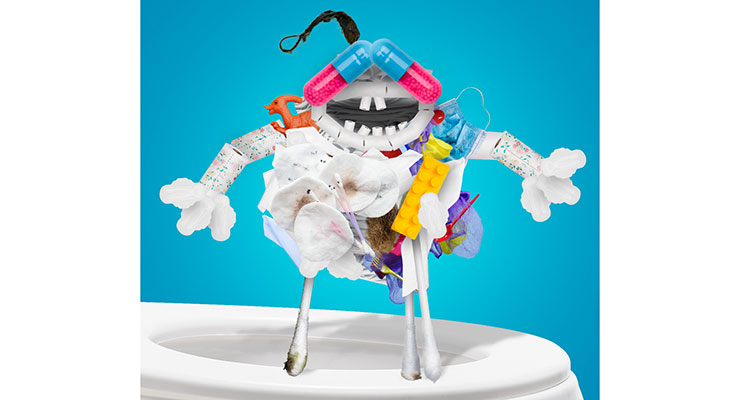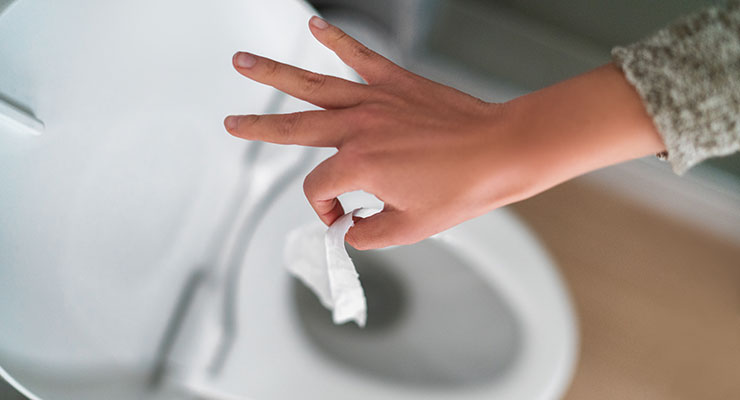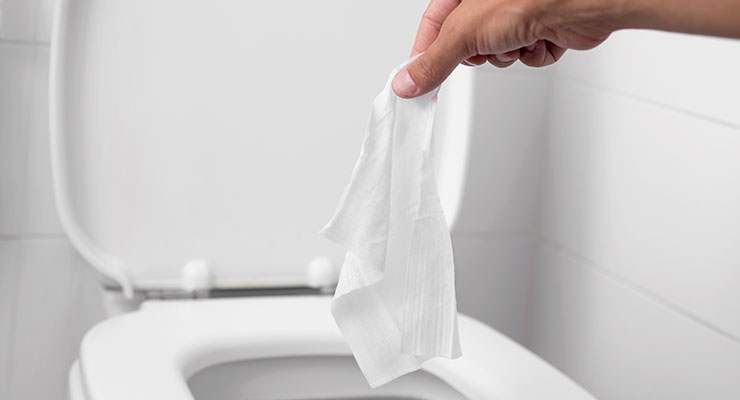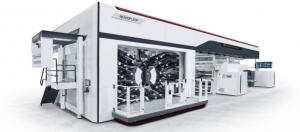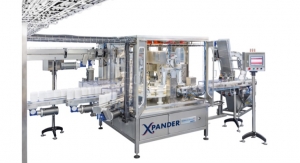Tara Olivo, Associate Editor04.01.21
Wastewater operators across the globe continue to face challenges associated with clogs due to issues such as aging infrastructure and improper flushing habits. While items such as baby wipes, paper towels, tampons and sanitary pads—products not intended to be flushed down the toilet—are being found in wastewater systems around the world, flushable wet wipes continue to garner much of the blame.
To address the need for long-term solutions to the problems in the nation’s wastewater systems, the Responsible Flushing Alliance (RFA) formed last year as an independent nonprofit with a mission of educating consumers about responsible and smart flushing habits in partnership with wastewater and sanitation industries.
Responsible Flushing Alliance Coalition Members include Albaad, Center for Baby and Adult Hygiene Products, Essity, First Quality, Georgia-Pacific, Johnson & Johnson, Jacob Holm, Kelheim Fibres, Kimberly-Clark Corporation, Nehemiah Manufacturing, Nice-Pak, Procter & Gamble, Rockline Industries, Sellars Nonwovens and Suominen Corporation.
The first initiative that the organization’s president Lara Wyss will spearhead for the RFA is a consumer and industry education campaign to raise awareness about the proper disposal practices for non-flushable products and to advocate for the prominent placement of “Do Not Flush” labels on non-flushable products.
Household & Personal Care Wipes spoke with Wyss about the alliance and its plans moving forward.
Household & Personal Care Wipes (HPCW): Can you talk about the formation of the Responsible Flushing Alliance? How did it come about?
Lara Wyss (LW): The Responsible Flushing Alliance was formed as an independent 501c6 organization in May 2020. The industry recognized that a robust educational effort needed to be undertaken to encourage proper disposal of single-use products. Our efforts are working to demonstrate how everyone can work together to promote home and community health by protecting the nation’s infrastructure.
HPCW: Can you describe some of the ways the alliance is reaching and educating consumers about the proper disposal of non-flushable products?
LW: The initial consumer outreach that the Responsible Flushing Alliance is undertaking focuses on educational social media campaigns, press outreach, and establishing relationships with trade associations, companies and wastewater sector advocates.
To kick off our campaign, we are providing public information to promote the “Do Not Flush” symbol. On the Responsible Flushing Alliance Facebook page you can see some of our messaging.
LW: As this is our first year as an organization, the Responsible Flushing Alliance is establishing itself as a resource for educational materials around smart flushing habits. We are doing this by creating a new website (www.flushsmart.com); reaching out to companies, NGOs and wastewater water sector advocates to share our work; and sharing resources through social and other media channels.
HPCW: What challenges does the RFA expect to face as it attempts to change consumer behavior on what not to flush?
LW: There are so many misconceptions about what can and cannot be safely flushed. My role as president of the Responsible Flushing Alliance is to open the door for conversations with friends and foes alike. So far, reception has been overwhelmingly positive.
HPCW: Can you talk about the initial awareness campaign in California? What are some of the efforts the alliance has made in the state so far?
LW: In California we are working with organizations such as the California Association of Sanitation Agencies (CASA) to provide educational information related specifically to what not to flush. Our initial efforts are focusing on the “Do Not Flush” symbol and we are looking at how to expand the campaign in the following months.
We are also working closely the State of Washington on launching a campaign very similar to what California is doing.
We are still in the very early stages of the campaign so stay tuned for more updates on our impact.
HPCW: What’s next for the group? What other states are on the agenda?
LW: As we continue to grow and have additional resources, we will expand our outreach to more areas of the country and eventually internationally. As a new (less-than-one year-under-our-belt) organization, Responsible Flushing Alliance has ambitious plans to add new supporting members and likeminded groups so that we can build on the great foundation we have established.
To address the need for long-term solutions to the problems in the nation’s wastewater systems, the Responsible Flushing Alliance (RFA) formed last year as an independent nonprofit with a mission of educating consumers about responsible and smart flushing habits in partnership with wastewater and sanitation industries.
Responsible Flushing Alliance Coalition Members include Albaad, Center for Baby and Adult Hygiene Products, Essity, First Quality, Georgia-Pacific, Johnson & Johnson, Jacob Holm, Kelheim Fibres, Kimberly-Clark Corporation, Nehemiah Manufacturing, Nice-Pak, Procter & Gamble, Rockline Industries, Sellars Nonwovens and Suominen Corporation.
The first initiative that the organization’s president Lara Wyss will spearhead for the RFA is a consumer and industry education campaign to raise awareness about the proper disposal practices for non-flushable products and to advocate for the prominent placement of “Do Not Flush” labels on non-flushable products.
Household & Personal Care Wipes spoke with Wyss about the alliance and its plans moving forward.
Household & Personal Care Wipes (HPCW): Can you talk about the formation of the Responsible Flushing Alliance? How did it come about?
Lara Wyss (LW): The Responsible Flushing Alliance was formed as an independent 501c6 organization in May 2020. The industry recognized that a robust educational effort needed to be undertaken to encourage proper disposal of single-use products. Our efforts are working to demonstrate how everyone can work together to promote home and community health by protecting the nation’s infrastructure.
HPCW: Can you describe some of the ways the alliance is reaching and educating consumers about the proper disposal of non-flushable products?
LW: The initial consumer outreach that the Responsible Flushing Alliance is undertaking focuses on educational social media campaigns, press outreach, and establishing relationships with trade associations, companies and wastewater sector advocates.
To kick off our campaign, we are providing public information to promote the “Do Not Flush” symbol. On the Responsible Flushing Alliance Facebook page you can see some of our messaging.
- What not to flush, based on forensic analyses of fatbergs, including feminine care products, disinfecting wipes, paper towels, and baby wipes. https://fb.watch/47AKFyQPVG/
- How to identify the Do Not Flush symbol on products that should not be flushed. https://fb.watch/47ARn-Zi0x/
- Financial implications for homeowners related to plumbing expenses created by improperly flushing and clogging your pipes. https://fb.watch/47AVQEl50j/
- Educating consumers that improper flushing may lead to community issues as our sewer systems run for miles under homes and throughout our communities. So just because it can be flushed, does not mean it should be. https://fb.watch/47B2G-xg8v/
- Reminding people that your toilet isn’t a trash can. https://fb.watch/47B3kLJICD/
- Providing tips and tricks for keeping a healthy home through smart flushing habits. www.facebook.com/ResponsibleFlushingAlliance/photos/a.129979741898601/243252490571325/
- And we’ve created a Clog Monster that is made up of things found in clogs. It’s a fun way to engage with people about what not to flush by not feeding the Clog Monster. https://fb.watch/47B9zdzHdH/
LW: As this is our first year as an organization, the Responsible Flushing Alliance is establishing itself as a resource for educational materials around smart flushing habits. We are doing this by creating a new website (www.flushsmart.com); reaching out to companies, NGOs and wastewater water sector advocates to share our work; and sharing resources through social and other media channels.
HPCW: What challenges does the RFA expect to face as it attempts to change consumer behavior on what not to flush?
LW: There are so many misconceptions about what can and cannot be safely flushed. My role as president of the Responsible Flushing Alliance is to open the door for conversations with friends and foes alike. So far, reception has been overwhelmingly positive.
HPCW: Can you talk about the initial awareness campaign in California? What are some of the efforts the alliance has made in the state so far?
LW: In California we are working with organizations such as the California Association of Sanitation Agencies (CASA) to provide educational information related specifically to what not to flush. Our initial efforts are focusing on the “Do Not Flush” symbol and we are looking at how to expand the campaign in the following months.
We are also working closely the State of Washington on launching a campaign very similar to what California is doing.
We are still in the very early stages of the campaign so stay tuned for more updates on our impact.
HPCW: What’s next for the group? What other states are on the agenda?
LW: As we continue to grow and have additional resources, we will expand our outreach to more areas of the country and eventually internationally. As a new (less-than-one year-under-our-belt) organization, Responsible Flushing Alliance has ambitious plans to add new supporting members and likeminded groups so that we can build on the great foundation we have established.

